Did you know that a single gallon of fuel is enough to power an entire high-speed train to go from New York to Los Angeles and back? Neither did I, but the U.S. High-Speed Rail Association (US HSR) made this preposterous claim on its web site last week. Someone there apparently figured out that it is ridiculous and took it down, but below is the graphic that accompanied the claim.
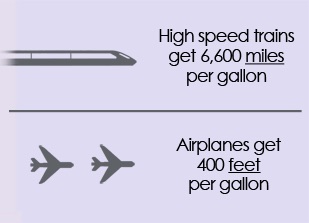 US HSR’s claim that high-speed trains can go 6,600 miles on one gallon of fuel is absurd, and its claim that airliners can only go 400 feet on one gallon is also wrong.
US HSR’s claim that high-speed trains can go 6,600 miles on one gallon of fuel is absurd, and its claim that airliners can only go 400 feet on one gallon is also wrong.
Like the claim that one rail line can move as many people as an eight-lane freeway, this claim for energy efficiency is startling enough that we are likely to hear it again as Democrats attempt to spend a few trillion dollars building a high-speed rail system across the country. In preparation for that debate, here are ten reasons why the United States should not build high-speed rail.
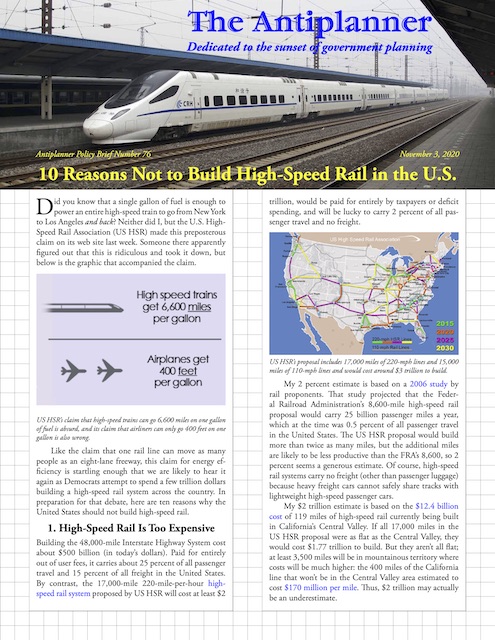 Click image to download a six-page PDF of this policy brief.
Click image to download a six-page PDF of this policy brief.
1. High-Speed Rail Is Too Expensive
Building the 48,000-mile Interstate Highway System cost about $500 billion (in today’s dollars). Paid for entirely out of user fees, it carries about 25 percent of all passenger travel and 15 percent of all freight in the United States. By contrast, the 17,000-mile 220-mile-per-hour high-speed rail system proposed by US HSR will cost at least $2 trillion, would be paid for entirely by taxpayers or deficit spending, and will be lucky to carry 2 percent of all passenger travel and no freight.
US HSR’s proposal includes 17,000 miles of 220-mph lines and 15,000 miles of 110-mph lines and would cost around $3 trillion to build.
My 2 percent estimate is based on a 2006 study by rail proponents. That study projected that the Federal Railroad Administration’s 8,600-mile high-speed rail proposal would carry 25 billion passenger miles a year, which at the time was 0.5 percent of all passenger travel in the United States. The US HSR proposal would build more than twice as many miles, but the additional miles are likely to be less productive than the FRA’s 8,600, so 2 percent seems a generous estimate. Of course, high-speed rail systems carry no freight (other than passenger luggage) because heavy freight cars cannot safely share tracks with lightweight high-speed passenger cars.
My $2 trillion estimate is based on the $12.4 billion cost of 119 miles of high-speed rail currently being built in California’s Central Valley. If all 17,000 miles in the US HSR proposal were as flat as the Central Valley, they would cost $1.77 trillion to build. But they aren’t all flat; at least 3,500 miles will be in mountainous territory where costs will be much higher: the 400 miles of the California line that won’t be in the Central Valley area estimated to cost $170 million per mile. Thus, $2 trillion may actually be an underestimate.
The Federal Railroad Administration’s 2008 proposal included about 8,600 miles of high-speed rail lines (shown in red) and would have cost about $1 trillion.
This doesn’t even count US HSR’s secondary network of 110-mile-per-hour rail lines, which I estimate are close to 15,000 miles long. US HSR may think that 110-mph trains can use existing railroad tracks, but most of the major freight railroads, including BNSF, CSX, and Norfolk Southern, have said they won’t allow passenger trains moving faster than 90 miles per hour to share tracks with their freight trains.
This means the secondary network will also have to be built from scratch. Brightline is spending $43 million per mile building 110-mph track from Cocoa to Orlando. At this price, and with at least 3,000 miles in mountainous territory, US HSR’s 15,000 miles of 110-mph routes would cost close to another $1 trillion. Note that, even after spending $3 trillion, the entire system will be only two-thirds as long as, and therefore at least that much less functional than, the Interstate Highway System.
To make it more politically attractive, the Obama administration added about 2,400 miles to the FRA proposal including lines to Duluth, Cheyenne, and a stand-alone line between Phoenix and Tucson.
Admittedly, US HSR’s proposal is much more ambitious than the FRA proposal. But the FRA proposal didn’t reach many major cities including Denver, Las Vegas, and Phoenix. To gain political support, the Obama administration updated the FRA proposal with a revised plan that included those cities, but still missed other major cities such as Nashville and Salt Lake City. The cities that were reached by the system often lacked connectivity; Phoenix travelers could go only to Tucson; Denver travelers could go only north or south, not east or west. Once the government funded some of these lines, political pressure would demand that a system much closer to US HSR’s be eventually completed.
No doubt high-speed rail proponents will predict lower costs, but costs always end up being higher than originally projected. In 1999, the 520-mile Los Angeles-San Francisco line was projected to cost $25 billion; the current projection is $80.3 billion. Even after adjusting for inflation, costs have more than doubled. Britain’s 345-mile London-Scotland HS2 high-speed rail line was originally projected to cost £32.7 billion (about $123 million per mile) and is currently expected to cost £106 billion ($400 million per mile).
Once built, it’s also expensive to keep high-speed rail in sound condition. Long-run capital replacement requirements include replacement of rails and trainsets about every 10 years. A country that can’t keep its urban rail systems in shape is not likely to be able to keep even more expensive high-speed rail lines running.
These capital replacement costs are often ignored by rail planners. The California High-Speed Rail Authority is legally required to earn enough revenues to cover its operations and maintenance costs. The agency’s business plans estimate future capital replacement costs (which it calls “lifecycle costs”), but when it projects the future profitability of the project, it only counts operations and maintenance costs, not lifecycle costs, against the revenues. This means taxpayers will be on the hook to cover those costs even in the unlikely event that the system managed to cover its operations and maintenance costs.
2. It’s an Energy Hog
US HSR’s claim that a single gallon of fuel can move an entire train 6,600 miles is clearly wrong. But most other claims about high-speed rail’s energy efficiency are also wrong.
For one thing, it takes a lot more energy to move a train at 220 miles per hour than to move one at conventional speeds of 70 to 80 miles per hour. “The power required increases with the cube of the train speed,” notes engineering professor Alan Vardy.
To make up for the cube law, high-speed trains are built especially light, but still require more energy to move. JR East, which operates both high-speed and conventional trains in Japan, says that, to move a train one kilometer requires 5 kilowatt-hours (about 17,000 British thermal units or BTUs) for a high-speed train but only 1.5 kilowatt-hours (about 5,100 BTUs) for a conventional train.
Many comparisons of high-speed trains with planes assumes both are equally full. But the pre-pandemic airlines filled about 85 percent of their seats while Amtrak fills only 52 percent of its seats. That’s because most airline flights are non-stop, so the airlines can base the size of the plane on the projected demand. Most passenger trains, however, make many intermediate stops, and the trains must be sized to meet the maximum demand along the route. As a result, many trains tend to be relatively empty for much of their journeys, greatly reducing their energy efficiency.
US HSR claim that a gallon of fuel could move a plane only 400 feet turns out to also be wrong, though not by as much as the train number. Based on ranges and fuel tank sizes, a Boeing 747-8 could move 745 feet per gallon; a 777-200LR could move 1,085 feet per gallon; and a 787-9 could move 1,390 feet per gallon.
Planes today use less than a quarter as much fuel per passenger mile as planes in 1970, making them energy competitive with rail travel. Photo by Dave Sizer.
Note that newer planes are much more energy efficient: the older 747-8 used 85 percent more fuel than the newer 787-9. The Department of Energy estimates that airliner fuel economy has improved by more than 300 percent since 1970, going from more than 10,000 to under 2,500 BTUs per passenger mile.
Despite steady improvement, almost every analysis comparing high-speed rail with airline energy efficiencies assumes that future airlines will be no more energy efficient than at the time of the analysis. In fact, because airplanes are not tied to one type of infrastructure the way high-speed trains would be, they can make improvements much faster than railroads.
The biggest factor working against the energy efficiency of high-speed rail is the huge amount of energy required to build it as well as to periodically replace infrastructure such as rails and power facilities. Airports are practically the only infrastructure required for airlines, but high-speed rail lines need mile after mile of roadbed, ties, rails, power supplies, signals, and stations to operate. Even if high-speed train operations used somewhat fewer BTUs per passenger-mile than airlines, the high energy costs of building and replacing infrastructure would more than make up for that savings.
Most of the electricity that would power U.S. high-speed trains is generated by burning fossil fuels, so rail won’t significantly reduce greenhouse gas emissions. While green-energy advocates hope to eventually replace fossil fuels, adding trains to electrical demands would simply increase the time and effort required to build a non-fossil-fuel electrical system. Moreover, the concrete ties, steel rails, and other infrastructure required for high-speed trains would generate huge amounts of greenhouse gases.
3. It’s Slow
Airlines are capable of cruising at more than 550 miles per hour. Adding the time required to take off and land reduces average speeds, but high-speed train average speeds are also a lot lower than 220 mph or whatever their top speed is. With intermediate stops, average speeds are typically about 80 percent of top speeds, so trains with top speeds of 220 mph may have average speeds of around 175 mph, which is well below the average speed of airliners.
Rail advocates argue that rail downtown-to-downtown times are competitive with planes, and that may be important for New York to Washington trips as there are nearly 2 million jobs near Penn Station in New York and 400,000 jobs near Union Station in Washington. But the jobs in most other American cities are far more dispersed. The Los Angeles airport, for example, has more jobs than downtown Los Angeles. Los Angeles and other major cities are also served by multiple airports, and when all the jobs and residences near those airports are counted, they can greatly outnumber those located in or near downtown.
The big slowdown in air travel is the time required to get through airport security. Yet security systems can be streamlined for a lot less than it would cost to build high-speed rail. At very little cost, for example, the Transportation Security Administration’s known traveler identification program allows frequent travelers to swiftly bypass many security steps.
If high-speed rail ever became a significant mode of travel, it too would require security systems. Wait times to pass through security to ride the Eurostar from London to Paris, for example, can sometimes be 30 minutes or more.
4. It Doesn’t Go Where You Want to Go
The Federal Railroad Administration’s proposed high-speed rail network was really six different and disconnected systems. Even within each system, the routes were incomplete: travelers could get from Chicago to St. Louis and from St. Louis to Kansas City, but there was no direct route from Chicago to Kansas City.
US HSR’s high-speed rail system corrects only a few of these problems. It still doesn’t include, for example, a 220-mph route from Chicago to Kansas City. The 220-mph network misses several urban areas with more than 500,000 people and even the 110-mph system skips many urban areas with more than 100,000 people.
People driving on an interstate freeway can get off the freeway at any exit and access the nation’s other 4.1 million miles of roads. Once rail passengers arrive at a station, they must find some other mode of travel to reach their final destinations, greatly reducing the convenience of the system.
5. It Won’t Get Many People out of Cars or Planes
The most heavily used high-speed rail lines in the world, including those in China, Europe, and Japan, gained their riders by attracting them out of conventional trains, not out of autos or airplanes. The United States doesn’t have enough conventional train riders for high-speed rail lines to succeed.
When Japan opened its first high-speed rail line in 1964, nearly 70 percent of passenger travel was by rail and only 12 percent was by automobile. Although Japan’s lines are considered high successful, today only 25 percent of passenger travel is by rail and nearly 70 percent is by auto.
Europe has seen extensive growth of high-speed rail lines since 1990. Yet the percentage of travel by rail has grown only slightly and much of that growth has been at the expense of intercity bus travel, not automobiles. Spain, for example, has more miles of high-speed rail lines than any other European country, yet rail travel has grown from 6.9 percent of surface travel in 1990 to 7.1 percent in 2018, while bus travel declined from 14.9 percent to 8.0 percent. Meanwhile, air travel within Europe is growing at 10 percent per year while rail travel is growing by just 0.2 percent per year.
China has built 22,000 miles of high-speed rail lines. . .
and at least 93,000 miles of freeways. Maps by Ythlev and Alan Fan Pei.
Detailed information about China isn’t available, but rail advocates often point to the fact that, as of August 2020, China has built 22,000 miles of high-speed rail lines. What they don’t say is that by the end of 2019 China has also built 93,000 miles of freeways—far more than the 67,000 miles in the United States—and that China expects to add 19,000 more by the end of this year.
Auto ownership in China is also rapidly growing, having more than tripled from 76 million cars in 2009 to 258 million in 2019. While China still has fewer cars per capita than the United States, it has more total motor vehicles. The growth in ownership is no doubt mirrored by the growth in driving, showing that high-speed trains are not reducing auto driving.
6. Dedicated Infrastructure Is Wasted
Highways, airplanes, and conventional rail lines can move people or freight. But high-speed rail lines can only move people, making them far less cost-effective. To save energy, high-speed rail cars are far lighter than conventional rail cars and cannot be safely used on the same tracks as frequent heavy freight trains. France does run some of its TGV trains on conventional lines, but those lines have very few freight trains compared with American railroads, so the danger is not so great.
High-speed trains may be pretty, but because they can’t carry freight they make sense only in corridors that can generate huge numbers of riders— and few if any such corridors can be found in the United States. Photo by tansaisuketti.
The requirement for dedicated infrastructure is a problem common to the pipedreams of many mass transportation enthusiasts, whether they are promoting light rail, monorails, maglevs, or personal-rapid transit. All of these systems are far more expensive to build than highways yet can’t do nearly as much.
7. There Is No Sweet Spot
A fundamental precept behind high-speed rail is that there is a “sweet spot” of distances between cities in which high-speed rail will thrive as the distance is too long for auto travel and too short for air travel. The FRA, for example, claims that this sweet spot is between 100 to 600 miles.
In fact, this is entirely speculative and there is absolutely no evidence that it is true. On one hand, many short-distance routes are served by numerous airliners each day. On the other hand, the distances people are willing to drive continue to grow.
Before the pandemic, at least 35 to 45 flights per day (depending on the day of the week) flew the 240 miles between Dallas and Houston, and nearly that many are going today. Most of these flights are provided by Southwest Airlines, which doesn’t use a hub-and-spoke model, so most of the people on those flights are only going between Dallas and Houston.
Alaska Airlines’ frequent service between its hub cities of Portland and Seattle demonstrates that air passengers can be attracted to flights under 200 miles. Photo by Eric Salard.
Similarly, Alaska Airlines had about two dozen flights a day each way between Seattle and Portland, whose airports are less than 170 miles apart. Both Portland and Seattle are hub cities for Alaska Air, so most travelers on these planes were not connecting with other planes.
Amtrak often brags that it carries more people than the airlines between New York and Washington, which are 230 miles apart. But it admits that it really has only 6 percent of the intercity travel market in the Northeast Corridor, with airlines carrying about 5 percent and the other 89 percent going by highway.
The coronavirus has increased people’s willingness to take long auto trips as an alternative to mass transportation. At the same time, driver-assist systems such as adaptive cruise control are making driving less stressful and increasing people’s tolerance for such long trips. With Waymo actually having self-driving cars for hire in the Phoenix area and Ford, GM, and Tesla working hard to catch up, the time-cost of auto travel is likely to sharply decline before the United States can build much of a high-speed rail network.
8. A Threat to the National Economy
A major problem for every country that has built high-speed rail is that, even if the first lines make economic sense, political pressures demand that the countries build more and more lines that are less and less sensible. Financing these lines requires huge amounts of debt that can significantly harm the national economies.
China has built more miles of high-speed rail than any other country and also has gone more into debt doing it. At the end of 2019, China’s state railway had $773 billion worth of debt and most of its high-speed rail lines aren’t covering their operating costs, much less their capital costs.
The trains that $773 billion worth of debt built. Photo by N509FZ.
France’s state-owned railroad has piled up debts of more than $50 billion and has been repeatedly bailed out by the government. About half the debt is due to operating losses and half is due to the expense of building new high-speed rail lines.
Spain has built its high-speed rail system with an availability-payment public-private partnership. Officially, the private partner has gone into debt by $18.5 billion. While the country is obligated to pay the private partner enough money that it can repay the debt, the debt isn’t on Spain’s books, which allows it to evade eurozone debt limits. If the EU changes its rules, however, Spain would be in serious trouble.
Japan provides an object lesson for what happens when a country has a rail debt crisis. In 1987, state-owned Japanese National Railways had a debt of $260 billion (in today’s dollars), much of it due to political demands to build money-losing high-speed rail lines. The Japanese government privatized the rail lines, selling them for less than 1 cent for every dollar spent building them, and absorbed the debt. Taking on that debt contributed to (and arguably caused) the decade or more of stagnation that the Japanese economy suffered after that time.
Most state-owned highways in the United States paid for themselves out of user fees. No one expects any high-speed rail lines to cover their capital costs, and most won’t cover their operating costs, out of user fees. This means they will be entirely political and significantly harmful to the nation’s economic future.
9. It Won’t Stimulate the Economy
Any large transportation facility, such as a train station, airport, or major freeway intersection, will draw new development. Someone opening a new restaurant, for example, may locate it near a popular train station rather than somewhere else. But just because the infrastructure has influenced the location of new development doesn’t mean that it generated net economic growth.
To produce actual economic growth, new transportation infrastructure must generate new travel or shipping that wouldn’t have taken place without the infrastructure. The Interstate Highway System, for example, stimulated millions of miles of new travel and ton-miles of new shipping that weren’t taking place before the highways were built.
To generate new travel, a new transportation system must be faster, more convenient, and less expensive than existing systems. High-speed rail fails all of these tests being slower than flying, less convenient than driving, and more expensive than both. For example, airfares average less than 14 cents per passenger mile, driving costs an average of 25 cents a passenger mile, while Amtrak fares for its high-speed Acela average nearly $1 per passenger mile.
10. A Source of Political Corruption
As with any megaproject, high-speed rail is a tempting target for people who would illegally or unethically divert government dollars to their own selfish interests. In 2013, after a fatal high-speed train crash attributed to the use of improper construction materials, China arrested and convicted Liu Zhijun, the state minister of railways, for embezzlement, accepting bribes, and conspiring to murder someone who threatened to expose him. He was sentenced to life imprisonment.
Because it is built in the mountains, the Jōetsu shinkansen required numerous tunnels, including one that is nearly 14 miles long. The high cost of the line, which was built solely for political reasons, contributed to the downfall of Japanese National Railways. Photo by Sakaori.
In 1974, Kakuei Tanaka had been prime minister of Japan for only two-and-one-half years when he left office under a cloud of scandal and corruption for accepting bribes and directing government contracts to businesses in his prefecture. One of the biggest projects he promoted was the Jōetsu high-speed rail line, one of the most expensive and least-used lines built in Japan. Tanaka’s hometown of Niigata, the line’s endpoint, has fewer than 800,000 residents.
Obama’s revised high-speed rail plan included a line to Duluth, Minnesota, which has only 120,000 people in its urban area. Not coincidentally, at the time the map was issued, the chair of the House Transportation and Infrastructure Committee was from Duluth.
Many people wonder why California started building high-speed rail in the Central Valley, which has the fewest number of people along the route. The answer goes back to 2010, when the Obama administration gave California a high-speed rail grant. Fresno Democratic Congressman Jim Costa was running a tough re-election campaign, so Obama required that funds granted to California be spent in or near Costa’s district and allowed Costa to announce the grant instead of the Secretary of Transportation, who usually made such announcements. Costa won by only 3,000 votes, so the grant may have made the difference to his campaign.
An Archaic and Obsolete Technology
The Tokyo-Osaka high-speed rail line made money, but it was built across fairly flat territory at a time when construction costs were low and in a corridor with some 60 million people. The United States has no corridors like that. The Paris-Lyon high-speed rail line supposedly made money, but it was built across flat land for less than $10 million per mile. No high-speed rail line will ever be built in the United States for such a low cost.
High-speed rail is an obsolete technology because it requires expensive and dedicated infrastructure that will serve no purpose other than moving passengers who could more economically travel by highway or air. The United States should not make the same mistake as China, Spain, and other countries that have gambled their economies on this archaic form of travel.

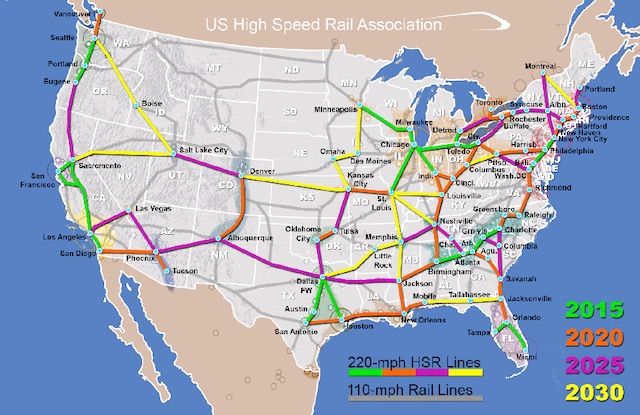
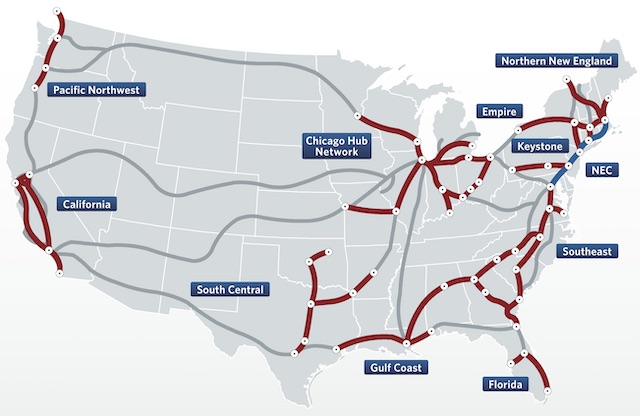
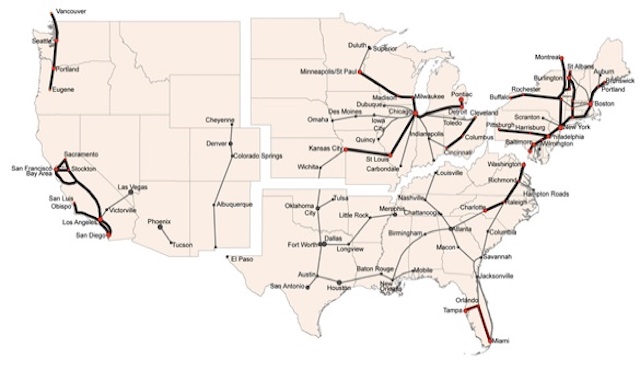
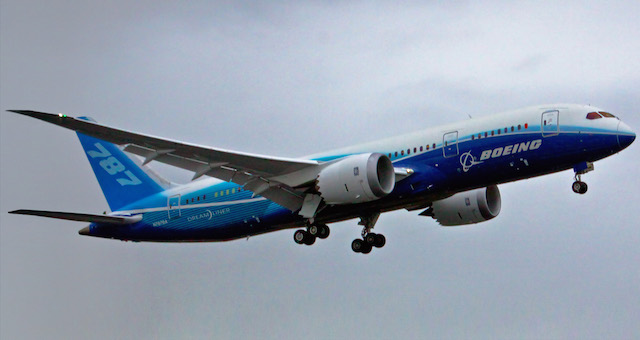
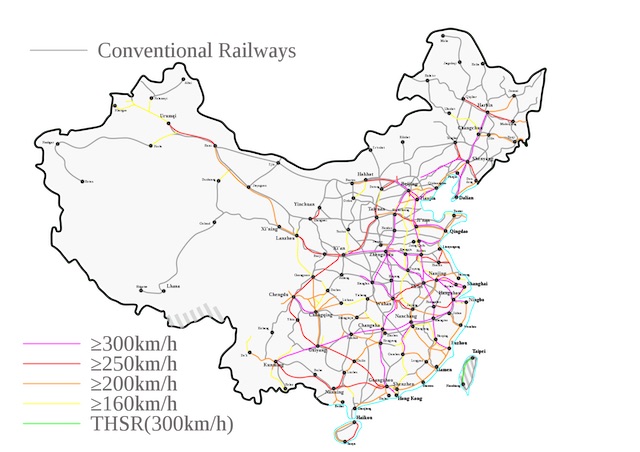
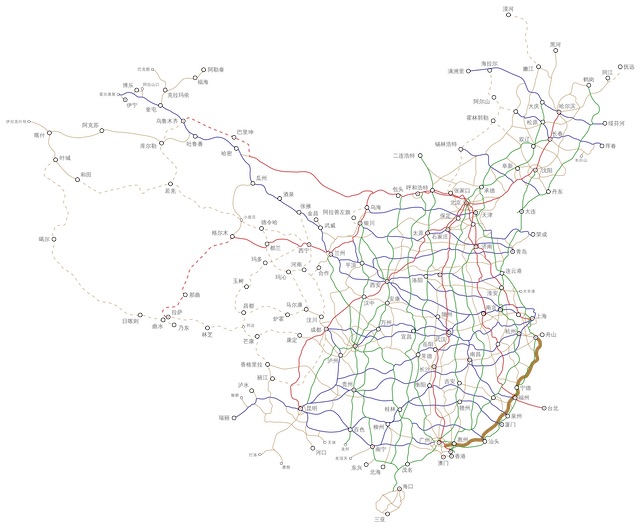
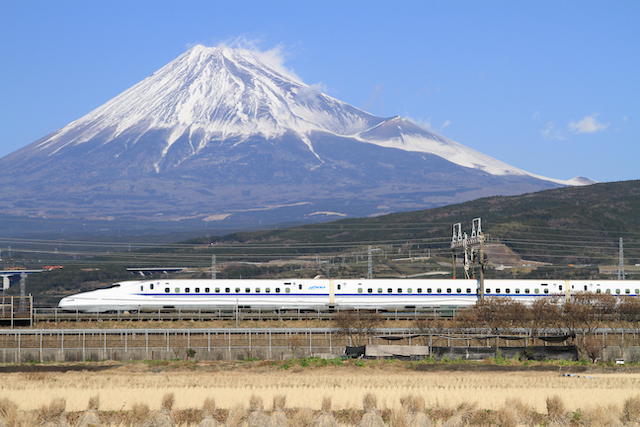
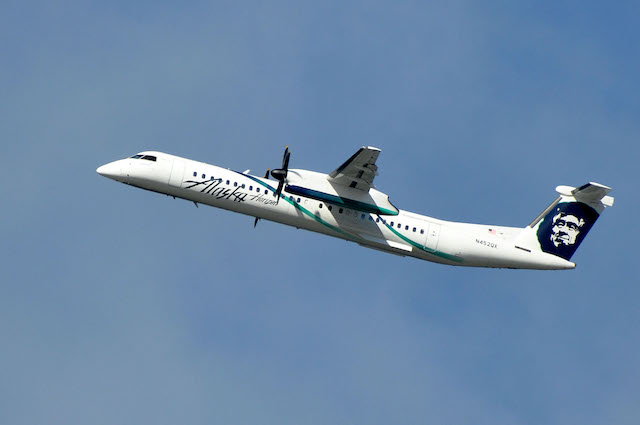
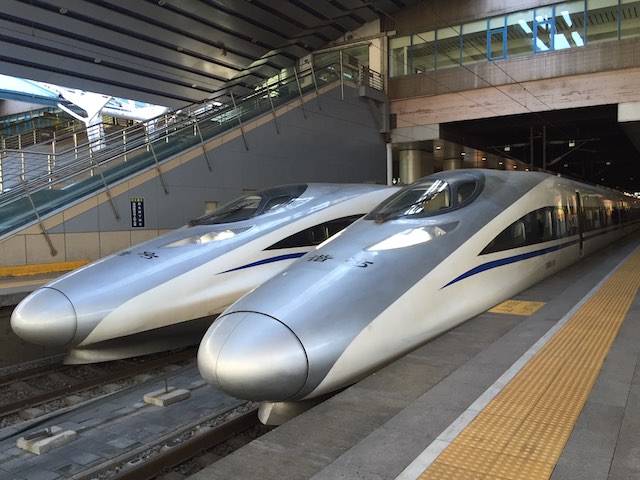
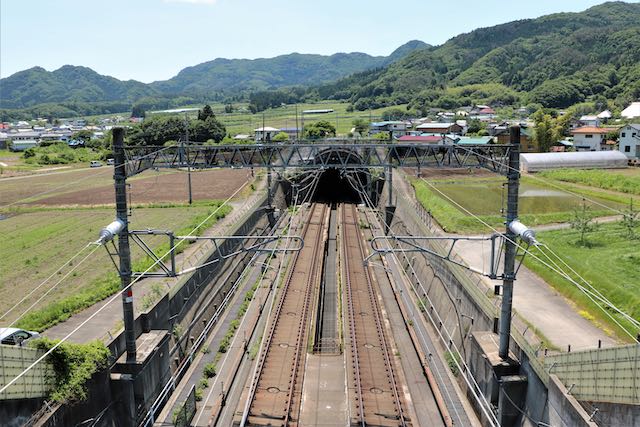







A couple of additional analyses that would be useful:
1. An energy use comparison between rail and driving assuming different types of vehicles ranging from economy cars to large SUVs at different levels of capicity (driver plus 1,2,3,4 etc passengers.
2. A cost analysis of rail infrastructure verses air (airports ATC etc) as well as highways.
3. A consumer based cost analysis of both time use and money allocated for distance travel either by rail, car, or place. I would subdivide this analysis into groups based on geographic location relative to the rail or airport infrastructure. My guess is that these proposals only add burdens to suburban and rural residents and are only convenient for urbanites.
4. A full cost absorption analysis of rail, flying, and driving which includes capital costs (vehicles and infrastructure) as well as unit costs such fuel and possible time used to travel either represented separately in terms of hour or converted or an average work hour wage. You could then represent it as a cost per mile traveled figure.
There may be hope in preventing high speed rail being built. I have been discussing the Green New Deal (GND) with a group of University of California employees who support the GND. They were shocked to see that high speed rail is mentioned in the GND, as advocates of CO2 reduction in California are now disillusioned with the incompetent mess that California high speed rail has become. GND proponents were also disturbed that and there is no cost per tonne of CO2 reduction mentioned in the GND. Therefore it is likely that proponents of CO2 reduction will be sensible enough to only advocate for technology that reduces CO2 production at the lowest cost. To reduce CO2 production can only be achieved by using technology that reduces CO2 at the lowest cost per tonne.
Two technologies under development will make automobile travel greener and more useful — electric vehicles and self-driving automobiles and trucks. The development costs will be provided by manufacturers while the capital costs will be covered by users’ new vehicle purchases.
Back in 2014 during one of the early public meetings for Texas Central, I was told that a train uses 9 Megawatts of power when running at full speed. It uses more during acceleration but this is partially offset by regenerative braking. At 320 km/h, it takes 11.25 seconds per km, which translates to 28 kilowatt-hours per km. This is well above the 5 kw-h/km reported in the article.
The Wikipedia link lists the EC as 18 kw-h/km, and it does not specify conventional or high speed.
I don’t know if the value of 9 Megawatts at full speed is correct. But the Japanese value of 5 kw-h/km seems suspiciously low. The Japan numbers on Wikipedia are per car-km. How many cars does a train have? Also, the Japanese number for 2017 is for conventional rail, and the 2004 number is “JR East Average”, which could be an average of conventional and high speed, and is 3.4 times higher than the 2017 conventional.
So I think high speed rail has much higher energy consumption than 5 kw-h/km. Since this article claims high speed rail is an energy hog, I would suggest verification of the actual value.
California cant even deliver electricity to it’s residents, but Electric cars you have to PLUG in are the way of the future. As for electric cars, it takes the energy of 80 to 300 barrels of oil — to fabricate a battery that can hold energy equal to one barrel just to make that battery pack. You have to mine 400 tons of rock and ore to make a 1200 lb battery. Even Tesla’s impressive sales — 500,000 cars sold in just six years after introduction — was smoked by the Ford Mustang: 2.5 million sold in its first six years. It’s no more revolutionary to change the fuel source of a car.
Typically vehicles range from compacts to SUV’s so they use between 18-50 pounds of copper in their manufacture for their wiring. A hybrid car on the other hand uses over 80 pounds copper, a Plug in hybrid uses about 132 pounds of copper and a Fully electric car uses between 180-350 POUNDS of copper; Over three or five times that of a normal car. Plus the charging infrastructure.